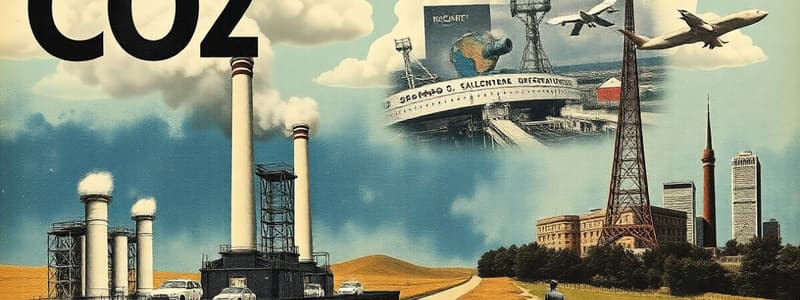Podcast
Questions and Answers
Which country has emitted more CO2 than any other country to date?
Which country has emitted more CO2 than any other country to date?
- China
- Brazil
- United States (correct)
- India
What percentage of historical CO2 emissions is attributed to the United States?
What percentage of historical CO2 emissions is attributed to the United States?
- 22%
- 50%
- 25% (correct)
- 30%
Which region has the smallest contribution to global CO2 emissions relative to its population size?
Which region has the smallest contribution to global CO2 emissions relative to its population size?
- Africa (correct)
- Europe
- North America
- Asia
Which factor is NOT a reason why developing countries are more vulnerable to climate change?
Which factor is NOT a reason why developing countries are more vulnerable to climate change?
What is a major effect of climate change on impoverished communities?
What is a major effect of climate change on impoverished communities?
What is essential for addressing climate change and sustainable development?
What is essential for addressing climate change and sustainable development?
What was the estimated total emissions of carbon in 2035?
What was the estimated total emissions of carbon in 2035?
What percentage of energy use in industry contributes to greenhouse gas emissions?
What percentage of energy use in industry contributes to greenhouse gas emissions?
Which sector accounts for the highest greenhouse gas emissions?
Which sector accounts for the highest greenhouse gas emissions?
What is the contribution of transport to total greenhouse gas emissions?
What is the contribution of transport to total greenhouse gas emissions?
Which category includes emissions from the production of energy from various fuels?
Which category includes emissions from the production of energy from various fuels?
What is the percentage of fugitive emissions from energy production?
What is the percentage of fugitive emissions from energy production?
Which of the following activities is NOT included in the calculations for transport emissions?
Which of the following activities is NOT included in the calculations for transport emissions?
What percentage of greenhouse gas emissions is directly accounted for by Agriculture, Forestry, and Land Use?
What percentage of greenhouse gas emissions is directly accounted for by Agriculture, Forestry, and Land Use?
Which of the following practices is associated with net emissions of carbon dioxide from changes in forestry cover?
Which of the following practices is associated with net emissions of carbon dioxide from changes in forestry cover?
What is the main greenhouse gas produced from the application of synthetic nitrogen fertilizers to agricultural soils?
What is the main greenhouse gas produced from the application of synthetic nitrogen fertilizers to agricultural soils?
What process in flooded rice fields leads to the production of methane?
What process in flooded rice fields leads to the production of methane?
Which agricultural practice accounts for 3.5% of greenhouse gas emissions through the release of various gases?
Which agricultural practice accounts for 3.5% of greenhouse gas emissions through the release of various gases?
What percentage of greenhouse gas emissions is attributed to rice cultivation?
What percentage of greenhouse gas emissions is attributed to rice cultivation?
What percentage of greenhouse gas emissions is linked to energy use in agriculture and fishing?
What percentage of greenhouse gas emissions is linked to energy use in agriculture and fishing?
Which of the following practices can lead to carbon sequestration in grassland?
Which of the following practices can lead to carbon sequestration in grassland?
What is the primary greenhouse gas produced by enteric fermentation in livestock?
What is the primary greenhouse gas produced by enteric fermentation in livestock?
Which agricultural product is associated with the highest carbon footprint due to livestock emissions?
Which agricultural product is associated with the highest carbon footprint due to livestock emissions?
What percentage of emissions comes from direct industrial processes?
What percentage of emissions comes from direct industrial processes?
What process contributes to methane production in landfills?
What process contributes to methane production in landfills?
Which industry process is responsible for producing carbon dioxide as a byproduct during clinker production?
Which industry process is responsible for producing carbon dioxide as a byproduct during clinker production?
What percentage of emissions is attributed to wastewater management?
What percentage of emissions is attributed to wastewater management?
Which chemical process generates emissions during the production of ammonia?
Which chemical process generates emissions during the production of ammonia?
What is a primary source of nitrous oxide emissions in agricultural soil?
What is a primary source of nitrous oxide emissions in agricultural soil?
Flashcards
Largest historical CO2 emitter
Largest historical CO2 emitter
The United States has emitted more CO2 than any other country, accounting for 25% of historical emissions.
EU-27 historical CO2 contribution
EU-27 historical CO2 contribution
The 27 European Union countries combined have contributed 22% of historical CO2 emissions.
Current vs. Historical Emitters
Current vs. Historical Emitters
Countries like India and Brazil are large emitters now but have a relatively smaller share of historical emissions.
Africa's CO2 Contribution
Africa's CO2 Contribution
Signup and view all the flashcards
Vulnerability of Developing Countries
Vulnerability of Developing Countries
Signup and view all the flashcards
Climate Change Impacts on Developing Countries
Climate Change Impacts on Developing Countries
Signup and view all the flashcards
Climate Change-Sustainable Development Strategy
Climate Change-Sustainable Development Strategy
Signup and view all the flashcards
GHG Emissions Increase
GHG Emissions Increase
Signup and view all the flashcards
Atmospheric CO2 Stabilization
Atmospheric CO2 Stabilization
Signup and view all the flashcards
Emissions Reductions
Emissions Reductions
Signup and view all the flashcards
Energy Use Sector (Electricity, heat, transport)
Energy Use Sector (Electricity, heat, transport)
Signup and view all the flashcards
Industrial Energy Use
Industrial Energy Use
Signup and view all the flashcards
Transport Emissions
Transport Emissions
Signup and view all the flashcards
Buildings Energy Use
Buildings Energy Use
Signup and view all the flashcards
Fugitive Emissions
Fugitive Emissions
Signup and view all the flashcards
Agricultural Energy Use
Agricultural Energy Use
Signup and view all the flashcards
Agriculture, Forestry, and Land Use Emissions
Agriculture, Forestry, and Land Use Emissions
Signup and view all the flashcards
Grassland Degradation
Grassland Degradation
Signup and view all the flashcards
Cropland Carbon
Cropland Carbon
Signup and view all the flashcards
Deforestation Emissions
Deforestation Emissions
Signup and view all the flashcards
Crop Burning Emissions
Crop Burning Emissions
Signup and view all the flashcards
Rice Cultivation Emissions
Rice Cultivation Emissions
Signup and view all the flashcards
Agricultural Soils Emissions
Agricultural Soils Emissions
Signup and view all the flashcards
Agricultural Soil Emissions
Agricultural Soil Emissions
Signup and view all the flashcards
Livestock & Manure Emissions
Livestock & Manure Emissions
Signup and view all the flashcards
Enteric Fermentation
Enteric Fermentation
Signup and view all the flashcards
Cement Production
Cement Production
Signup and view all the flashcards
Chemical & Petrochemical Emissions
Chemical & Petrochemical Emissions
Signup and view all the flashcards
Wastewater Emissions
Wastewater Emissions
Signup and view all the flashcards
Landfill Emissions
Landfill Emissions
Signup and view all the flashcards
Study Notes
Global CO2 Emissions
- The United States has emitted more CO2 than any other country, accounting for 25% of historical emissions – twice that of China.
- The European Union (EU-27) is also a significant historical contributor, at 22%.
- Many current large emitters, like India and Brazil, are not major historical contributors.
- Africa's contribution is minimal, due to historically low per capita emissions.
Developing Countries and Climate Change Vulnerability
- Developing countries face more severe climate impacts, like frequent floods and droughts.
- These countries have a larger portion of their economies tied to climate-sensitive sectors.
- They have less capacity to adapt due to lack of financial, institutional, and technological resources.
- Climate change disproportionately affects the poorest, exacerbating inequalities in health, food, and water access.
Integrated Climate Change and Sustainable Development
- A former viewpoint separated climate change and development as distinct issues.
- A more modern view emphasizes integrating climate change goals into sustainable development strategies.
- These strategies now aim to manage the relationship between both simultaneously rather than as separate considerations.
Expected Increase in GHG Emissions
- In 1995, developing countries accounted for 27% of global GHG emissions, while developed countries made up 73%.
- Projections suggest a significant shift in 2035, with developing countries' share increasing to 50% and developed countries remaining approximately 50%.
- China's share is significant and expected to increase further.
Actions to Reach Net-Zero Emissions by 2030
- Increase solar and wind capacity dramatically, to 500 gigawatts.
- Eliminate coal-fired electricity generation.
- Maintain current natural gas generating capacity for reliability.
- Increase sales of zero-emission vehicles.
- Increase sales of building heat pumps.
- Develop and deploy carbon capture and sequestration technologies.
- Build carbon dioxide and hydrogen gas pipelines for transportation.
Global Greenhouse Gas Emissions by Sector (2016)
- Energy is the largest contributor to global greenhouse gases, comprising 73.2% of emissions.
- Energy consumption across various sectors (industry, buildings, and transport) accounts for most energy usage.
- Agriculture, Forestry, and Land Use (AFOLU) contribute 18.4%, encompassing activities like deforestation and crop burning.
Direct Industrial Processes
- Cement production releases significant amounts of carbon dioxide.
- Chemical and petrochemical processes are sources of various greenhouse gases.
Waste
- Wastewater and landfills generate methane and nitrous oxide as organic matter decomposes in low-oxygen environments.
Studying That Suits You
Use AI to generate personalized quizzes and flashcards to suit your learning preferences.




